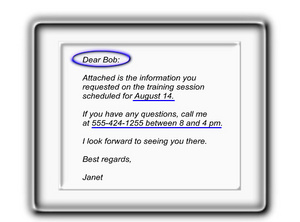How one writes electronic communication in a chat room is informal and filled with shorthand expressions. This type of electronic writing is not appropriate for business communications. There are formalities that must be considered and subscribed to, when creating electronic business communication.
The art of letter writing was at its height in the 18th century. In those days, telephones didn’t exist and travel was long and tedious, so most of the communication was through the written word. People who could read and write, became masters at the art of wordsmithing. Today’s communications, especially in the form of email, require brevity. Yet, because of the need for brevity, there is a strong need for conciseness and good email etiquette.
One of the most potentially hazardous elements to email communication is the writer’s inability to communicate tone or expression-the non-verbal communications that accompany phone calls or face-to-face conversations. Because of this, words can often be misinterpreted and people can take offense at the message, even though there was no offense intended. Email etiquette can help you avoid this situation.
General Formatting For Email
· Keep it brief; try not to go beyond what can be viewed in the window of the monitor, without scrolling.
· Set your word wrap for 70-80 characters, this prevents odd spacing and line breaks (setting can usually be found in the preferences option of your email client).
· Use punctuation and capitalization as you would in a business report or memorandum.
· Ensure your subject line accurately represents the content, i.e., Preparation for Meeting, August 24, 9:00 am. One word subjects such as “important” or “urgent” are unlikely to attract anyone’s attention, because these words are overused to the point of an anesthetic affect (everything is important, so nothing is important).
· Use a salutation or greeting such as “Dear Bob” or “Dear Mr. Roberts” unless the email is part of an ongoing e-versation (electronic conversation).
· Select the plain text option rather than HTML to ensure all recipients can view the message (some email clients do not read HTML).
· Be sure any attachments are in a format that the receiver can access or in plain text and that they have a title identifying its contents.
· Do not copy the world, include only the individuals immediately concerned with the information in your address or cc fields.
· Use bullets to convey lists of items or information; do not use numbers, unless there is a need for sequence.
· Use bold, italics and white space to make important information bits stand out, within the email, such as times, locations, dimensions or specifications.
· Don’t send unnecessary emails.
·. If you are writing to your boss, you may need to be more formal than if you are writing to a coworker. Always focus on the primary recipient. If you are planning to include technical information in your email, be sure you do so at a level every recipient can understand. If you are technically proficient and know many technical terms on a subject, it does not mean you should use them in the email. This would be particularly detrimental to your business health, if you talk over your boss’ head. It is important to remember that when you create an email you are attempting to communicate something. If no one can understand the communication, you are not communicating.
Think Twice About What You Write
If you think your email will only be seen by the receiver, you may find that you are very wrong. Many businesses today routinely monitor employee email transmissions. Also, someone may print a copy of an email you send on a shared printer and nearly anyone in the organization could see it-copy it-circulate it. It could get ugly. When you write, keep it factual and include only information that would be acceptable in a public arena. Limit your use of emoticons (smiley faces, winks, icons) to individuals with whom you have a casual relationship, but even then, think it through. Never use any emoticons or chat room shorthand when writing to higher ups in the organization.
No Flaming
Have you ever been flamed for flamed someone else? Flaming is a term used to describe verbal nastiness, venting emotion and in general being deriding or demeaning to or about others. If you are angry or upset, the same “count to ten rule” applies for email as for opening your mouth. Don’t rashly-without thinking-spill out your feelings into an email. Once the words are in black and white and the send button is pushed, they can never be taken back. Be sure what you are about to write is something that you are prepared to say to the person face to face and discuss in a rationale way. Otherwise, you are setting yourself and possibly others up for a conflict. Even if the conflict takes place solely in the virtual world, it will have emotional affects on everyone involved. You cannot hide forever behind the monitor; eventually it will be in your face in some way
Is Email The Best Medium?
Depending on the message itself, its length, its sensitivity, the possibility of misinterpretation, the importance of its content and what you stand to gain or lose from it, you must always consider whether or not an email is the best way to share the information. A phone or face-to-face conversation may be a better choice when there is the potential for reaction or misinterpretation, because there is the immediate opportunity for explanation and discussion. If the information is lengthy, put it on paper, fax or mail it, or make it an attachment to the email that can be printed. People really do not like reading lengthy documents online.
Conclusion
Email is a wonderful tool, if you use it correctly. However, with any tool, you should learn how to use it in a proper way and for the right type of work. Email cannot replace the face-to-face conversation and it should never be used as a substitute when it comes to dealing with or developing interpersonal relationships. A good working relationship can quickly turn bad, if one forgets email etiquette.





